Reading, Berkshire
Up to 1834
In December 1624, Reading received a bequest of £8,400 in the will of wealthy London draper John Kendrick. The money was designated for several causes but the bulk, £7,500, was to establish a workhouse. The mayor and burgesses were to purchase:
The residue of the bequest was to fund a:
A bequest of £4,000 was made on identical terms for the setting up of a workhouse in Newbury.
In January 1626, the town corporation paid William Kendrick (John's brother) the generous sum of £1,900 for his house and workshops on Minster Street, opposite St Mary's church, and with handy access to the Holy brook and Mill stream. By 1628, the site had been redeveloped to provide a workhouse for poor clothiers. The impressive building (for which William Brockman, brickmaker of Tilehurst, supplied 200,000 bricks and 20,000 tiles) became known as "The Oracle" — the name possibly deriving from "orchal", a violet dye obtained from lichen. It consisted of rows of workshops around a central courtyard, with Kendrick's remodelled house forming the north and east sides. The main entrance, at the north side was through an ornate dutch-gabled stone gateway.
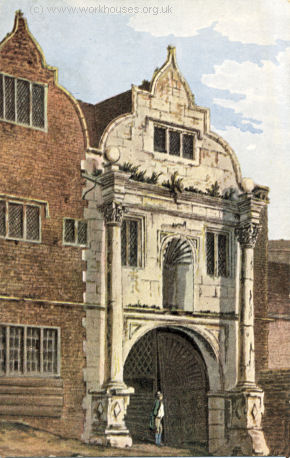
The Oracle, 1802.
© Peter Higginbotham.
The premises included a large dye-house containing three furnaces, two woad vats and a float vat), a stockarding house, a medling loft with beating hurdles, several weavers' shops containing six broad looms and a kersey loom, and various clothworkers' shops. By 1633, a Widow Lampit had been given the free use of several rooms in the workhouse to teach and set the poor on work is spinning and carding. A small amount of residential accommodation was also provided for several employees including the overseers of the weaving and clothworking shops.
The workhouse was run by several "undertakers" — local clothiers, appointed by the Corporation, who organised the cloth production for which they received loans from the common stock. In 1628, the first intake of 24 weavers, 16 shearmen, and six burlers took up employment at the workhouse. For its first two years, the operation ran at a profit but this soon began to change. Complaints also began that insufficient work was being created for the poor. In 1639, the workhouse was reorganised to provide training and employment for fatherless children.
The Oracle became a troop garrison during the English Civil War, and then 'an Habitation for an idle sort of Poor, who lived in it Rent free.' The building was demolished in 1850 and the site redeveloped. A link to the location's past comes through the present-day shopping complex on the site, which is named The Oracle.
Later parish workhouses included: St Giles', an old building on Horn Street for 62 inmates; St Laurence's, a group of old cottages on Thorn Street, for 100 inmates; and St Mary's, a building on Pinkney's Lane dating from the 1770s, also for 100.
Eden, in his 1797 survey of the poor in England, reported of the St Mary's workhouse that:
After 1834
Reading Poor Law Union was formed on 10th August 1835. Its operation was overseen by an elected Board of Guardians, 15 in number, representing its 3 constituent parishes as listed below (figures in brackets indicate numbers of Guardians if more than one):
Berkshire: St Giles, with Whitley (5); St Lawrence, Reading (5); St Mary, with Southcot (5).
The population falling within the union at the 1831 census had been 16,042 — 5,112 in St Giles 4,048 in St Lawrence, and 6,882 in St Mary. The average annual poor-rate expenditure for the period 1832-35 had been £8,179 or 10s.2d. per head.
For the first 30 years of its life, Reading Union made use of two of the pre-1834 parish workhouses which were adapted and enlarged: St Mary's (160 inmates) was for the aged, the infirm, the sick, mothers with children, and children without parents; St Laurence's (190 inmates) was used for able-bodied paupers and vagrants. The St Giles' workhouse was closed. In 1846, the Poor Law Commissioners expressed concern about sanitary conditions at St Laurence's. and suggested the building be replaced. This suggestion dismissed by the guardians, although in April of the following year an additional workhouse was opened specifically to accommodate the 'wayfaring and vagrant poor'. This was in an old granary at the entrance to King's Meadows in the Forbury. Only one night's stay was allowed, in return for which, a quarter pound of oakum had to be picked within four hours.
Finally, in 1865, a site was bought for a new workhouse on the north side of the Oxford Road near Battle Farm. The new Reading workhouse followed the design of the East Grinstead workhouse built in 1859 which comprised receiving blocks, an infirmary and a fever block. (Vagrants continued to accommodated at the Forbury until 1892.) A competition between seven local architects took place to produce plans for a building costing no more than £6,700. The accommodation was required to house 106 males and 95 females, including 102 aged and infirm, 76 able-bodied, 13 infants, and 10 imbeciles and epileptics. The infirmary was to have male and female wards each with 13 beds, a three-bed and a four-bed itch ward (for scabies), two bedrooms for dirty cases, and a lying-in room for three women and three infants. The fever block was to hold three of each sex.
The winning design was by a Mr Woodman, and building began in April 1866. The plans were revised in January 1867 to add an extra storey to the infirmary, adding £430 to the price. The total cost, including furniture and fittings, was in the region of £14,000. The first inmates were admitted in August 1867 and by the end of the year the paid medical staff consisted of a nurse at a salary £20 per annum, an assistant nurse, and a nurse for the idiots and imbeciles.
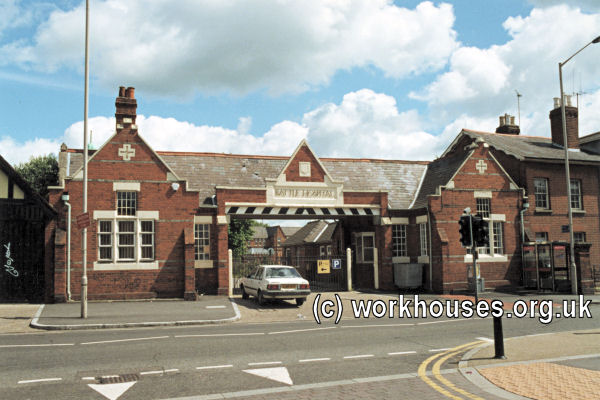
Reading Workhouse - Gatehouse.
© Peter Higginbotham.
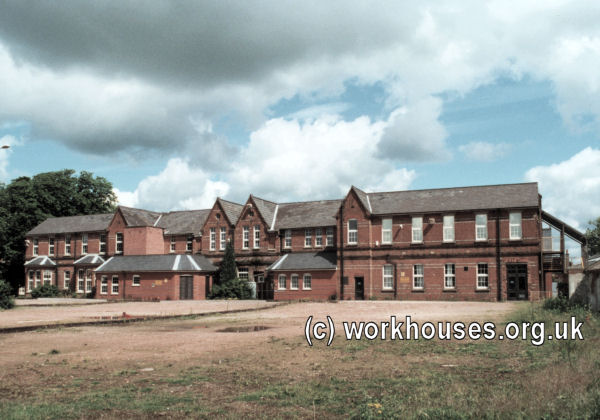
Reading Workhouse - Original infirmary.
© Peter Higginbotham.
A new infirmary was added at the west of the workhouse in 1892 and the old infirmary became a female residential block, with the old workhouse being used entirely for males. Accommodation for vagrants was also added. The layout at this time is shown below.
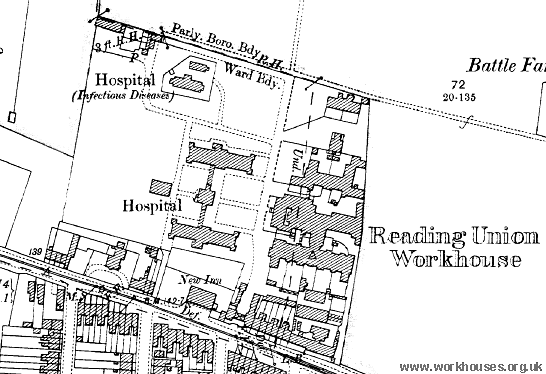
Reading Workhouse site, c.1900.
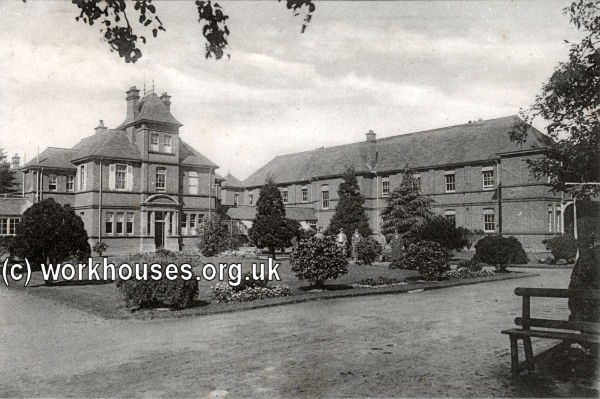
Reading Workhouse - 1892 Infirmary from the south-east, c.1915.
© Peter Higginbotham.
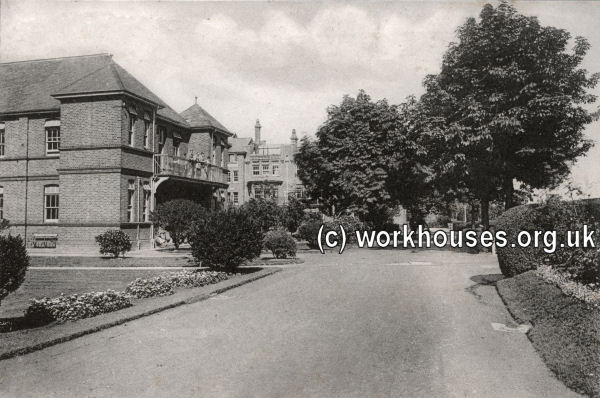
Reading Workhouse - 1892 Infirmary from the south, c.1915.
© Peter Higginbotham.
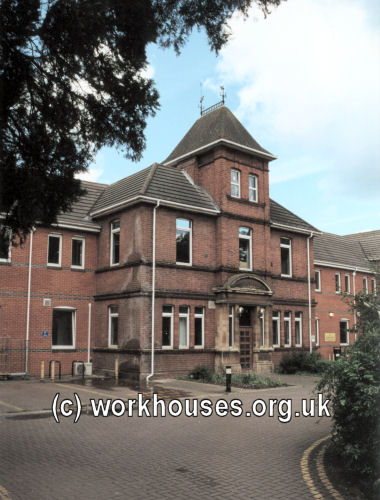
Reading Workhouse - 1892 Infirmary from the south-east, 2000.
© Peter Higginbotham.
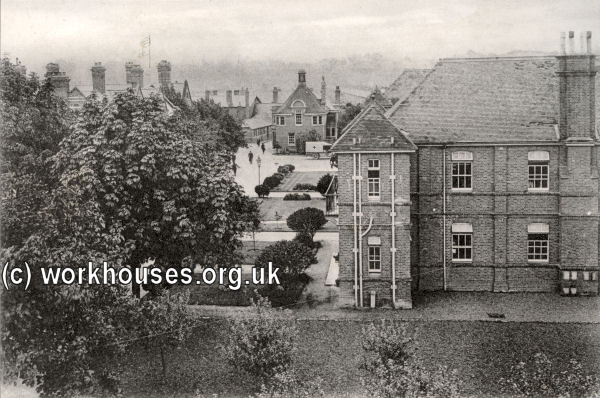
Reading Workhouse - 1892 Infirmary from the north, c.1915.
© Peter Higginbotham.
In 1894, the British Medical Journal set up a "commission" to investigate conditions in provincial workhouses and their infirmaries. Following a visit to Reading, the commission's report gave the establishment a glowing report. Unlike many other workhouses reviewed by the commission, Reading had a modern infirmary and a well-resourced nursing section which included a sister, four nurses, and two probationers. Two nurses were on duty at night-time, and pauper assistance was confined to activities such as cleaning and bed-making. Further details are available in the full report.
In 1909-11 an additional infirmary block was added at the north of the site for up to 150 aged, infirm and convalescent patients. In addition, a new board room, administrative block and master's house were added.
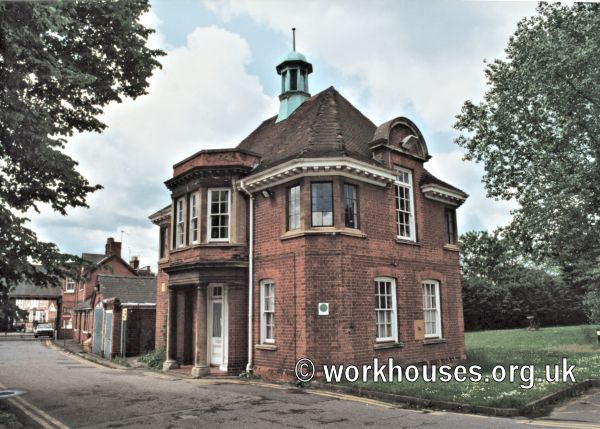
Reading Workhouse - Board-room, 2000.
© Peter Higginbotham.
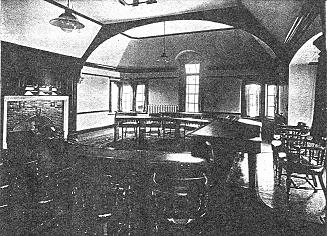
Reading Workhouse - Board-room interior, 1911.
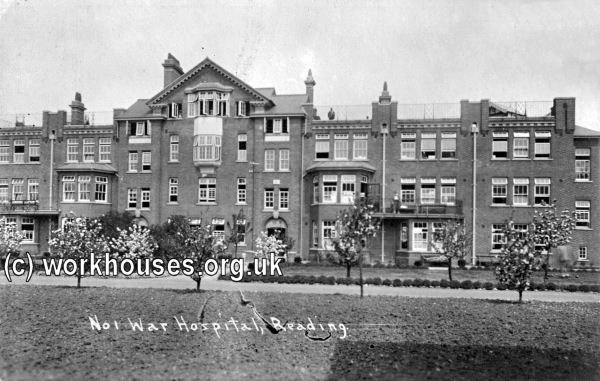
Reading Workhouse - 1911 Aged and infirm block, c.1915.
© Peter Higginbotham.
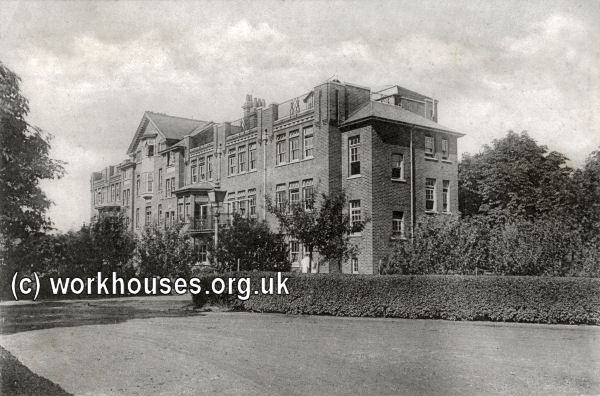
Reading Workhouse - 1911 Aged and infirm block, c.1915.
© Peter Higginbotham.
On March 1st 1915, the War Office requisitioned the Reading workhouse for use by the military authorities. All the inmates were transferred to other workhouses in the area, and the infirmary patients moved to Grovelands School nearby. Within six weeks, the workhouse was transformed into the Reading Number One War Hospital which, linked together with more than twenty other auxiliary hospitals in Berkshire, constituted one of the country's biggest war hospitals.
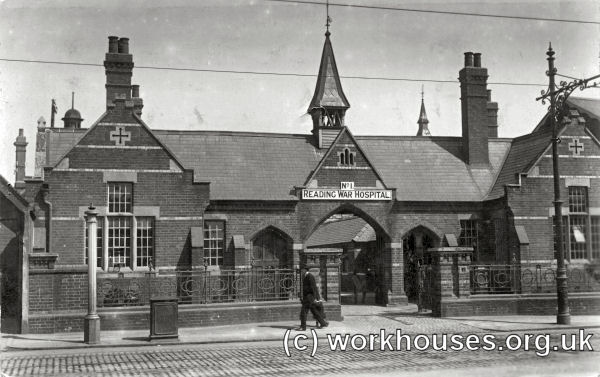
Reading Workhouse as War Hospital, c.1915.
© Peter Higginbotham.
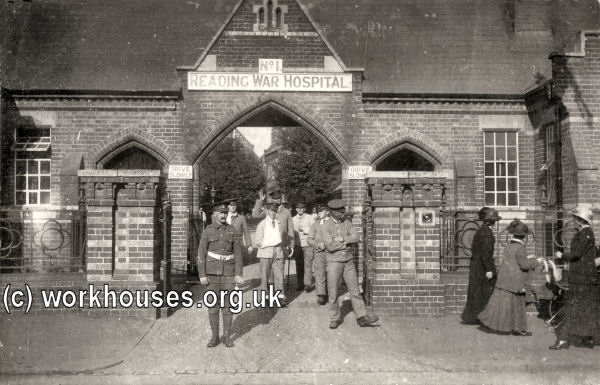
Reading Workhouse as War Hospital, c.1915.
© Peter Higginbotham.
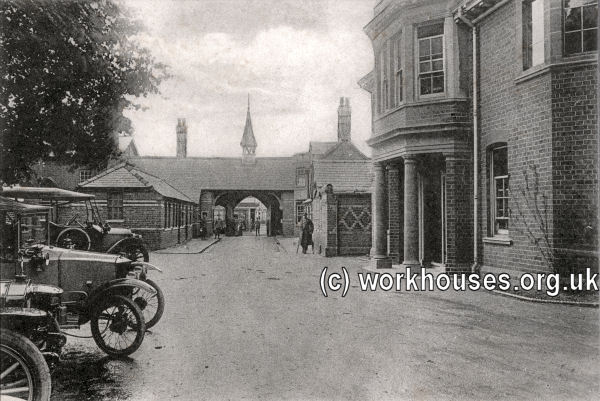
Reading Workhouse as War Hospital, c.1915
© Peter Higginbotham.
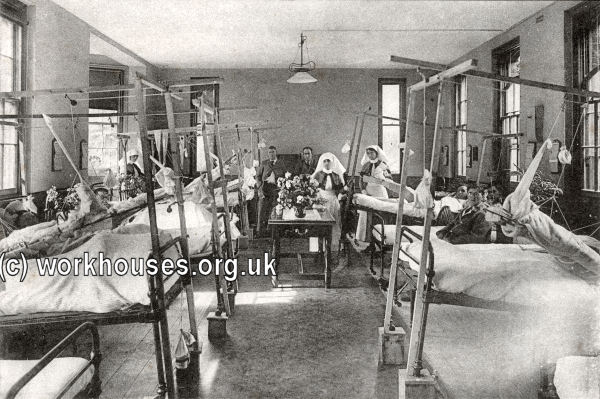
The Workhouse as War Hospital during WW1.
© Peter Higginbotham.
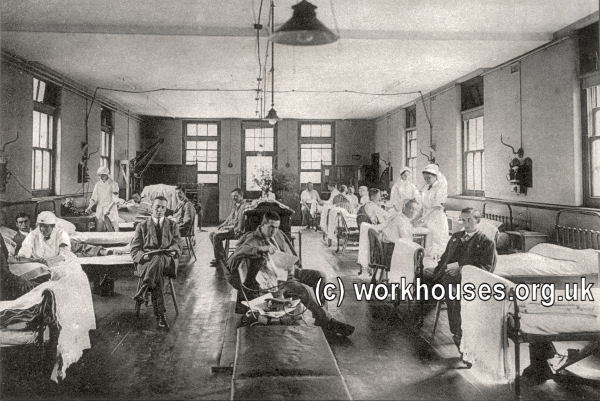
The Workhouse as War Hospital during WW1.
© Peter Higginbotham.
The workhouse site was finally handed back to the Board of Guardians in 1920. The following year, the workhouse was renamed Battle Infirmary, reflecting it increasing role as a provider of medical care to the poor in the area, not just workhouse inmates.
Following the abolition of the workhouse system in 1929, the workhouse was taken of by the Reading County Borough Council and became Battle Hospital. Following the closure of casual wards at Windsor, Easthampstead, Maidenhead, Wokingham, and Henley, a brand new casual ward was opened to the east of Reading at Woodley, near the junction of the Reading and Bath Roads where Norwich Drive now stands. The new Woodley Institution was officially opened ion 27th March, 1931. The cross-shaped main building contained an administrative block, wards and cells, together with a labour yard and labour master's house.
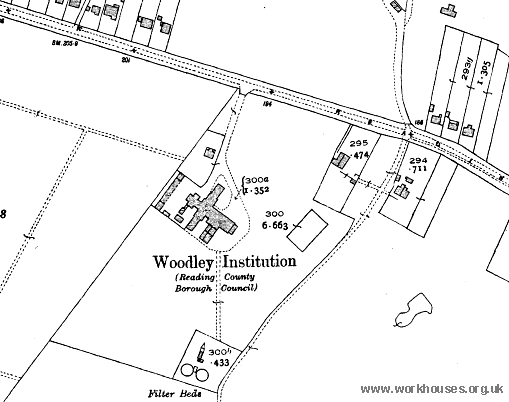
Reading Woodley Institution, c1931.
The hospital finally closed in 2005 and the buildings have been demolished except for the gatehouse and board-room.
Children's Homes
In 1849, the Reading Union joined with the neighbouring Wokingham Union to form the Reading & Wokingham School District and operated a residential school for pauper children at Gargrave until the early 1900s.
Reading then adopted the 'scattered homes' system for its pauper children, setting up a number of homes around the town, including: 82-84 Crescent Road; 'Camarra' and 'Rosemont', King's Road; 109 London Road; 11-13 Milman Road; 59 Queen's Road; 23-25 and 40 Russell Street; 'Wilson' and 'Clifford', South Street; and 'Ashberry' and 'Sutton', Southampton Street. A receiving home for new admissions was based at The Beeches, 109 London Road, Reading.
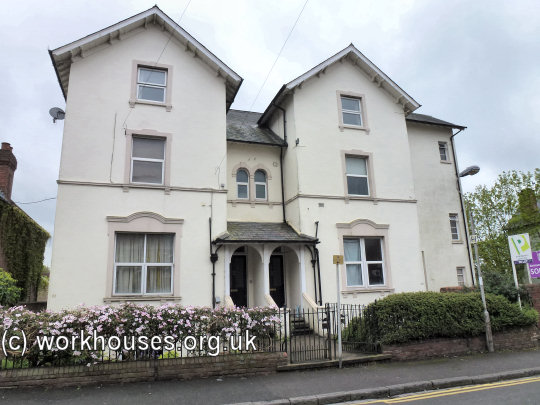
Former scattered homes, 11-13 Milman Road, Reading, 2014.
© Peter Higginbotham.
Former scattered homes, 82-84 Crescent Road, Reading.
Staff
Inmates
Records
Note: many repositories impose a closure period of up to 100 years for records identifying individuals. Before travelling a long distance, always check that the records you want to consult will be available.
- Berkshire Record Office, Berkshire Record Office, 9 Coley Avenue, Reading, Berks RG1 6AF. Only pre-1910 records are Guardians' minute books (1835-1930).
Bibliography
- Higginbotham, Peter Workhouses of London and the South East (2019)
- Jackson, Christine (2004) Functionality, Commemoration and Civic Competition: A Study of Early Seventeenth-Century Workhouse Design and Building in Reading and Newbury in Architectural History, 47, pp77-112.
- Railton, Margaret (1994) Early Medical Services — Berkshire and South Oxfordshire from 1740 (Polmood Publications).
- Railton, Margaret and Barr, Marshall (2005) Battle Workhouse and Hospital 1867-2005 (Berkshire Medical Heritage Centre).
Links
Unless otherwise indicated, this page () is copyright Peter Higginbotham. Contents may not be reproduced without permission.


